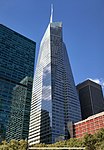Penn Club of New York

The Penn Club of New York (usually referred to as The Penn Club) is an American private, social club located in the Midtown Manhattan neighborhood of New York City. Its membership is restricted to University of Pennsylvania alumni, students, faculty, and family members thereof, with affiliate and reciprocal membership to select institutions. Originally occupied by the Yale Club of New York City, the 14-story clubhouse is on the National Register of Historic Places. For numerous consecutive terms, The Penn Club won the Platinum Club of America award, placing it in the top 3% among 6,000 clubs in the U.S. for perceived excellence, and ranked #14 best city club in the U.S., and #2 city club in New York City.
Excerpt from the Wikipedia article Penn Club of New York (License: CC BY-SA 3.0, Authors, Images).Penn Club of New York
West 42nd Street, New York Manhattan
Geographical coordinates (GPS) Address Nearby Places Show on map
Geographical coordinates (GPS)
| Latitude | Longitude |
|---|---|
| N 40.755279 ° | E -73.9839628 ° |
Address
Bank of America Tower
West 42nd Street 115
10036 New York, Manhattan
New York, United States
Open on Google Maps









